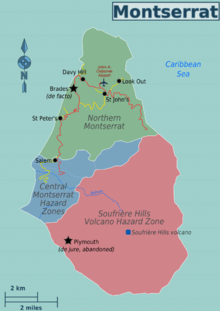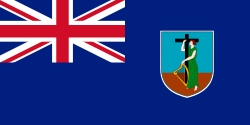Irish immigration to Montserrat

Irish immigration to Montserrat dates back to the 17th century during the period of plantation owners and slavery. Montserrat is a Caribbean island and overseas territory of the United Kingdom. It is also known as "The Emerald Isle of The Caribbean" due to the large population of people with Irish descent living there.[1] Irish people first arrived to the island in 1632 and people of mixed race with Irish descent still live on the island.[2]
Background
Irish people were originally sent to Montserrat as indentured servants, exiled by Cromwell. However, the dynamics of this Irish population in the Caribbean soon changed to a point where the Irish families became the wealthiest of the islanders. Demands for more Irish migrants increased as the link between Europe and the Caribbean strengthened. Many Irish merchant families from towns like Waterford and Galway created trading networks with the Caribbean.[3] The West Indies was a hub of the Atlantic trading system.[4] Large numbers of Irish people emigrated to Montserrat, generally as merchants laborers and servants. By the mid-seventeenth century Irish Catholic families accounted for the majority of the island's small but growing population. These numbers exploded as more than 10,000 Catholics traveled to Montserrat during Oliver Cromwell's The Protectorate during the 1650s.[5] Irish people accounted for almost 70% of Montserrat's white population by the late seventeenth century.[4] As time progressed some Irish merchant families became involved and established in funding the prosperous tobacco trade.[4] These Irish people not only made up most of the population but they grew wealthy and played a huge role in the island's economy, becoming far more successful than their English and Scottish counterparts because, as one contemporary explained, ''They knew how to be tough and efficient slave masters.''[4]
Slavery and indentured servitude
Irish settlement in Montserrat was strongly associated to the growth in slavery and the trade that accompanied it. Indentured servants accounted for the majority of people migrating to Montserrat.[6] Almost fifty to sixty percent of the labour flow from Britain to its many colonies during the early seventeenth century were servants.[7] Many Irish migrants were attracted to the large supply of employment available in the sugar industry. This production of sugar was fueled by planters with Irish descent with over a third of the island's sugar estates being run by Irish families[8] Some wealthy Irish merchant families set up plantations and networks in the Caribbean which provided employment for the thousands of Irish immigrants willing to travel to Montserrat. Almost half of the whole population of the West Indies by the mid-seventeenth century were Irish.[9] By 1730 Montserrat's economy was almost entirely dependent on this industry which resulted in a change in the population demographics as more slaves from Africa were required as labourers to keep the booming industry going.[8] The decline of the sugar industry resulted in a decline of the number of labourers needed, from 1735 onwards saw a decrease in sugar production which had detrimental effects on those relying on it as a source of income. Slavery was abolished in Montserrat in 1834[10]
Culture and Influence
The remains of Irish culture in Montserrat are evident in modern times. This can be seen in the islands flag and crest which portrays a woman with a harp and cross. Montserrat's national emblem is an Irish shamrock adorning Government house, again associated with the traditional Irish shamrock. Other cultural influences include music, value systems, and the Irish recipe for the national dish "goat water stew." These influences are a large part of Irish heritage in Montserrat history.[11] The spoken language of the island is English and the native inhabitants of Montserrat have an accent with a hint of Irish brogue.[12]

St. Patrick's Day
Identified as a national holiday in Montserrat, Saint Patrick's Day is a week long festival celebrated every year since 1985.[8] It is a day spent in celebration of the uprising by the enslaved and the free communities against the oppression and poverty suffered at the hands of the wealthy plantation owners. Along with traditional Caribbean entertainment, the festival also provides a rich mix of African and Irish heritage.
See also
References
- ↑ "Montserrat | island, West Indies". Encyclopedia Britannica. Retrieved 2017-07-17.
- ↑ MESSENGER, JOHN C. (1967). "The Influence Of The Irish In Montserrat". Caribbean Quarterly. 13 (2): 3–26. JSTOR 40653014.
- ↑ The Irish diaspora. Bielenberg, Andy, 1959-. Harlow, England: Longman. 2000. ISBN 978-0582369979. OCLC 42752389.
- 1 2 3 4 Ireland and the British Empire. Kenny, Kevin, 1960-. Oxford: Oxford University Press. 2004. ISBN 978-0199251834. OCLC 76961190.
- ↑ Harman Akenson, Donald (1997). if the Irish ran the world : Montserrat. liverpool.
- ↑ Beckles, Hilary McD. (1990). "A "riotous and unruly lot": Irish Indentured Servants and Freemen in the English West Indies, 1644-1713". The William and Mary Quarterly. 47 (4): 503–522. doi:10.2307/2937974. JSTOR 2937974.
- ↑ Garvey, Donal (1985). The History of Migration Flows in the Republic of Ireland. p. 24.
- 1 2 3 Ryzewski, Krysta; Cherry, John F. (2015). "Struggles of a Sugar Society: Surveying Plantation-Era Montserrat, 1650–1850". International Journal of Historical Archaeology. 19 (2): 356–383. doi:10.1007/s10761-015-0292-7.
- ↑ King (1945). European International Migration. p. 43.
- ↑ "Montserrat | island, West Indies". Encyclopedia Britannica. Retrieved 2017-07-26.
- ↑ "Culture of Montserrat - history, people, clothing, beliefs, food, customs, family, social, marriage". www.everyculture.com. Retrieved 2017-07-27.
- ↑ "International Phonetic Association | ɪntə'næʃənəl fə'nɛtɪk əsoʊsi'eɪʃn". www.internationalphoneticassociation.org. Retrieved 2017-07-27.